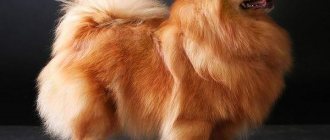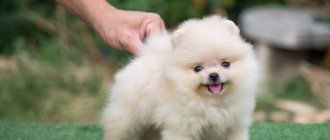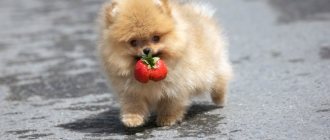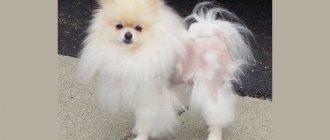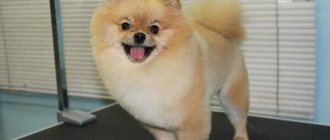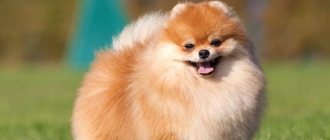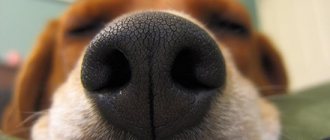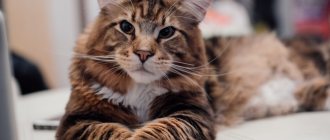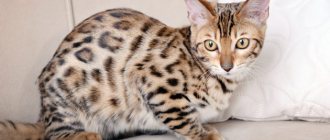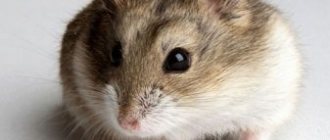The German Spitz and the Pomeranian are closely related. Around the world they are treated differently - in some countries dogs are recognized as a single species, in others - as separate breeds. But no matter how opposing the opinions of experts, animals still have differences in appearance. The article examines what is the difference between these pets, what characteristics they have in common, and what traits are directly opposite.
External differences
To understand how to distinguish a Pomeranian from a German Spitz, it is necessary to take a closer look at their exterior. Main differences:
- size;
- head structure;
- paw placement;
- tail position;
- wool structure.
According to FCI standard No. 97, the Pomeranian is a variety of the German. In general, the document divides Spitz into 5 types depending on height:
- Keeshond – 43-55 cm;
- large grossspitz - 42-50 cm;
- medium-sized Spitz - 30-38 cm;
- small Kleinspitz – 23-29 cm;
- Miniature Spitz (Pomeranian) – 18-22 cm.
Dogs shorter than 18cm are not welcome. However, in America a different classification has been adopted - Pomeranians are animals whose weight is less than 3 kg and whose height is less than 29 cm.
The body formats of the Pomeranian and German Spitz are the same - the length is equal to the height. However, the figure has differences - the Germans are more graceful. Pomeranians are small bears: round and fluffy.
Next, the external differences of both animals are examined in detail.
| Become | Description of the German Spitz | Description of the Pomeranian Spitz |
| Head | Miniature, wedge-shaped, fox-like. The stop is weakly expressed, the forehead is smoothed. | The shape resembles that of a bear - the muzzle is short, flattened, the stop is clearly visible. The forehead is strong and sloping. |
| Ears | Sharp, placed close. | Small, with rounded ends. Widely spaced. |
| Teeth | Exactly 42 pcs. | The absence of premolars is not prohibited. |
| Forelegs | The pasterns are located at an angle of 20°. The paws are small and thin, like those of a fox. | Perpendicular to the ground. The paws are thick and strong, like those of a bear. |
| Tail | Screws into a single or double ring. | Straight, thrown over the back. A tail twisted into a half ring is not considered a defect. |
Another difference between the German Spitz and the Pomeranian is the structure of the coat:
- Germans have double coats. The top hair is hard, straight or slightly wavy. The undercoat is dense and silky;
- in miniature spitz guard hairs are either absent or invisible. The coat is soft and lush due to the long undercoat. The dog feels like a plush toy to the touch. On the face the hairs are arranged in a fan, on the head - in the form of a cap.
You can see the external differences between the Pomeranian and the German Spitz in the photo.
The FCI standard clearly distinguishes the colors of Germans:
| Kind of animal | Allowed colors |
| Keeshond | Zone gray |
| Grossspitz | Black, chocolate, white. |
| Mittelspitz | Species listed plus orange, cream, cream sable, orange sable, black and tan, spotted. |
| Kleinspitz | |
| Zwergspitz |
Some colors of oranges go beyond the FCI standard:
- chocolate sable;
- chocolate and tan;
- brindle;
- blue;
- blue and tan;
- blue-sable;
- tricolor.
In America there is no such restriction.
Main differences of the breed
The differences between Germans and Pomeranians are noticeable, and even a non-professional breeder will immediately see that these are different dogs, despite the presence of common features. First of all, the differences between the Miniature Spitz and the German appear in size. The first are an exclusively dwarf species, in which even overgrowths at the withers are not more than 30 cm. The second breed is dwarf, medium and large, which is why its representatives at the withers are from 25 cm to 55 cm, and overgrowths are 65 cm. The rest The differences between the animals are also quite pronounced.
- Figure. The Germans are distinguished by great grace and smartness. Their body is elongated, fitting into a rectangle. Pomeranians are dense and have a square body. Miniature dogs look more like a bear cub.
- The front paws of a naturally bred dog are set at an angle of 20° , which creates the effect of being raised on tiptoes. Animals of the dwarf form, obtained artificially, have their front paws set perpendicular to the ground, which makes their body position seem particularly stable and their gait somewhat peculiar.
- The coat of the Germans, in addition to the undercoat, has straight and hard guard hair, which does not require special care, since the animal was not bred as a decorative animal, but was supposed to be hardy, not requiring significant attention from the owner. Miniature Spitz dogs begin to get sick without grooming . They require constant care from the owner.
- The coloring of the natural form is determined strictly by the growth of the animal. Any deviations in this indicator are considered a defect. Miniature dogs can have any of the 9 colors characteristic of the species.
- Dogs' muzzles do not have the same proportions relative to the forehead and nose. Germans are more like a fox, and Pomeranians are more like a bear cub. The transition between the forehead and the nasal part of both species is visible very clearly.
- The ears of a miniature dog are located quite far from each other and shifted to the sides of the head. Their size is small. The classic Spitz is distinguished by close-set ears, which are moved towards the top of the head. The size of the shells is large.
- Naturally shaped dogs have full and strong teeth The dwarf variety is distinguished by an incomplete set of teeth, which is why it requires delicate nutrition.
Maintenance, nutrition and care must meet the special requirements that are necessary to maintain the health of the orange. It should be noted that no less care will be taken with other dwarf breeds. If you don’t plan to constantly tinker with your pet’s fur, and you also don’t have the opportunity to spend a lot of time creating a special menu for the animal, you should pay attention to the German Spitz, which is larger and stronger. This dog was originally intended for use on the farm as a watchman and shepherd, which is why unpretentiousness was the main requirement.
Are there any differences in character?
Both Pomeranians and German Spitz are friendly, active, intelligent and loyal to their owners. Dogs are easy to train, but without training they become eccentric, stubborn and selfish. There are no significant differences in the temperament of both breeds.
Puppies are socialized as early as possible:
- they are taught to treat strangers and relatives calmly;
- set a daily routine;
- wean off “bad habits”.
Animals tend to dominate, so even in childhood it is necessary to establish the correct hierarchy.
Pets love to walk and are ready to accompany their owners even on long journeys. To prevent them from getting bored, they are provided with a lot of colorful toys. Due to lack of attention, animals bark, howl, and chew things and furniture.
Thanks to proper socialization, German and Pomeranian Spitz get along well with children and other pets. But a small child can accidentally injure the dog, so it is better not to leave them alone.
Origin of the breed
In our country, only the Deutscher Spitz is considered an independent breed, and the Pomeranian/Miniature Spitz is only one of its five tall varieties.
German Spitz dogs are descended from turf dogs dating back to the Stone Age and the later Pile Spitz . The Deutscher Spitz, as the oldest breed, became the ancestor of many European breeds.
The homeland of the smallest German Spitz is called Pomerania, from which they got their name “Pomeranian Spitz” or “Pomeranian”. The dogs “moved” to Great Britain under Queen Victoria, who acquired her own miniature dog named Marco. At this time, around 1870, intensive breeding work with Pomeranians began, aimed at improving their appearance (including size) and character.
A few decades later, Pomeranian Spitz reached America, where local breeders really liked them, adding their own touches to the cute dwarf dogs. Since then, the dissimilarity between the “Pomeranians” and the “Germans” became visible to the naked eye, and the United States began to call itself the second homeland of the Pomeranian Spitz.
Important! The Pomeranian is recognized as a special breed by the American Kennel Club, as well as clubs in England and Canada. The Fédération Cynologique Internationale (FCI) and its member RKF have registered only the German Spitz, classifying the “Pomeranian” as one of its varieties.
By the way, since July 19, 2012, by decision of the RKF, the names of the growth varieties themselves have undergone changes, and now in all internal pedigrees, instead of “miniature/Pomeranian Spitz,” they write “miniature/Pomeranian Spitz.” In export pedigrees, Pomeranians are called “deutscher spitz-zwergspitz/pomeranian”.
Return to content
Nuances of maintenance and care
Spitz are domestic dogs. They are not suitable for outdoor living. But due to high activity, pets require regular walking. Extended exercise allows them to stay in excellent physical shape. With proper care, representatives of both breeds live 14-15 years.
Caring for these animals is approximately the same. The only difference is that the fur of oranges requires more attention. Pets are brushed every other day with a soft brush, which does not pull out hairs, but massages the skin. You need to act carefully - the soft undercoat is easy to damage, which is why your pet will look bald.
To prevent the fur from puffing up in different directions, it is sprayed with conditioner or antistatic agent.
Pomeranians are also cut for two purposes:
- aesthetic - animals are made to look like cubs or lions;
- hygienic - hair is removed along the edges of the ears and around the anus.
Show dogs are cut to highlight their strengths and hide their shortcomings. To solve these problems, the services of a professional groomer are required.
Unlike Pomeranians, Germans only need to be brushed a couple of times a week. There is no need to groom your pets. Representatives of both breeds are bathed with special shampoos as they become dirty.
Animals must be dried with a hairdryer, otherwise the thick undercoat will remain damp. During molting, bathing procedures are avoided - there is a high risk of damaging the structure of the fur.
It is forbidden to cut off the fur completely - the hair will be restored very slowly or will not grow at all. This difference is common to all types of Spitz.
There are differences in animal health. The Germans are unpretentious - this is due to their long-term use as guards and shepherds. Pomeranians are exclusively decorative pets. They are more picky about their diet and are prone to certain diseases associated with their body type.
How to distinguish puppies
Purebred Pomeranian or German Spitz are very rare in Russia - the RKF allows the crossing of representatives of both species. Therefore, it is becoming increasingly difficult to understand the difference between a German and an Pomeranian. The most common were the so-called intermediate dogs, called German Pomeranians. They combine signs of two types.
Until three months of age, it is almost impossible to distinguish a Pomeranian from a German Spitz. Externally, the puppies are very similar, but it is very difficult to predict what the pet’s final height will be.
If you need to purchase a purebred animal, you should do the following:
- find a cattery with a good reputation, registered with the FCI;
- study the pedigree - the puppy’s parents may be of the same species, but its grandparents may be different. Puppies from such litters have significant differences and often do not meet the standard.
The weight of a Pomeranian puppy at 3 months should be less than 1 kg. If the animals are heavier, most likely they belong to the Small Spitz group.
Unscrupulous breeders pass off large, younger Spitz dogs as miniature Pomeranians. To avoid mistakes, it is recommended to buy grown-up juniors. Also, during molting, it is easier to notice differences in body structure.
The cost of puppies is approximately the same:
- pet class - 20-25 thousand rubles;
- breed class – 30-50 thousand rubles;
- show class - from 70 thousand rubles.
It is better not to buy from the hands of animals - you can buy a sick dog or a pet that has striking differences from the standard.
To breed Germans, an exhibition rating of at least “very good” and a pedigree are required. In England, the USA and Canada it is allowed to crossbreed all dogs that have official documents.
Origin
All Spitz dogs are descended from Scandinavian dogs that were used for guarding, herding and hunting in the northern regions. Natural selection selected only strong individuals resistant to adverse conditions, whose offspring gradually formed the breed. As a result, fluffy dogs of various sizes were obtained, resistant to many diseases and distinguished by intelligence and contact.
Pomeranians are the result of selection work based on the German breed. The reason for breeding the decorative variety was the desire of the aristocracy to have miniature-sized dogs that would look like a living toy. Modern breeders have further improved the decorative appearance of dogs, achieving a particularly abundant coat.
Breed gradation in different countries
The emergence of an independent breed called the Orange Spitz is associated with clubs in the USA, Canada and England. They considered that the characteristics of these dogs as a result of selection were very firmly fixed, and the differences in structure were so significant that it was impossible to regard the animal as a variety of German. In other countries, including Russia, Pomeranians are registered as a dwarf variety of the German Spitz. It is difficult to determine which classification is correct.
Dimensions
According to the European standard, the Miniature Spitz is significantly smaller than according to American standards. In the first case, the maximum height at the withers is 22 cm, and in the second – up to 30 cm. The maximum weight of mini-dogs is no more than 3 kg.
A dog of natural selection, according to the standard, has from 20 to 55 cm at the withers. Its weight, depending on its size, can range from 3 kg to 30 kg. Individual individuals that exceed the standards in growth gain weight up to 40 kg.
Color
Germans have a breed color that strictly corresponds to their size. In total there are 5 varieties of Germans. Because of this, when getting such a pet, you need to know exactly which color is acceptable for which variety. Oranges have no restrictions on color, and various variations are possible that are not related to growth. Even dogs with white markings are allowed.
Head shape
A feature of the head of a dwarf-sized dog is the ratio of the front to the forehead of 2:4. The frontal part, overhanging, is slightly pushed forward. The German form has an elongated facial part, and the forehead of these dogs does not protrude forward. It deviates towards the back of the head. The transition from the front to the forehead is pronounced in both types of dogs, but in the German it is smoother .
Teeth
The natural form of the animal retained all its teeth. After changing teeth, a dog grows 42 teeth.
The dwarf form of the Spitz, due to the lack of need to eat roughage, and also due to the fact that during breeding the main attention was paid to external data, has lost some premolars. If there is a shortage of them, individuals are still allowed to reproduce. It is possible for them to have a full dentition, but it does not happen often.
Who is better to choose
It’s difficult to say for sure which of the representatives of the breeds in question is worth choosing. The decision depends on the purpose for which a person gets a pet.
The animals have external differences, but their character is equally friendly. They are perfectly trainable and get along well with children and other four-legged human friends. Dogs will be excellent companions for active people who are able to allocate enough time for communication and joint games.
An unpretentious German can be raised into a good guard and protector, and a Miniature Spitz will only be a cute decorative companion dog. This is another difference between these animals.
Busy people are better off looking at another breed - lack of attention gives rise to aggression and self-will.
The main differences between German and Pomeranian Spitz are size, head shape, paw and tail placement, and coat structure. The character of both animals is approximately the same - cheerful and playful. Pomeranians do not have such good health, which must be taken into account when choosing a pet.
Pomeranian Spitz
Description
The Pomeranian Spitz originated in Germany - Pomerania, where the name of its breed comes from.
It is the smallest variety among the Spitz, which is why for a long time America and Russia called this breed dwarfs or miniature Spitz.
Despite the fact that the Pomeranian is a decorative breed of dog, the pet has good ingenuity and intelligence, so it copes well with the training course.
Photos of dogs
Spitz dogs are distinguished by their miniature size and the unprecedented beauty of their coat - soft, cotton wool with a rich undercoat gives the dog an airy appearance.
No less attention is paid to the thick collar and fluffy tail, which has the habit of resting on the pet’s back.
The dog has medium-sized, dark eyes. The look is attentive, playful.
Due to its light weight, the Pomeranian moves easily and flexibly, and often breaks into a run.
Character
The Pomeranian has a rather impulsive temperament.
The dog is an ardent fan of movement, which is why he will never prefer calmness to active play. He will happily run around the yard and bark, inviting you to share his joy. The pet is also quick to adapt and will happily accompany its owner on trips.
The dog is suspicious of strangers and is unlikely to approach first; he would rather watch the stranger on the sly.
In relations with the owner, the dog often shows stubbornness, moreover, it may try to challenge the leadership in the house. The Spitz is far from a modest dog; it is difficult for her to refuse the opportunity to subjugate anyone.
When a new addition to the family occurs, a dog may even show dissatisfaction, so it is important to raise and train a puppy from childhood. Otherwise, the Pomeranian will be happy to be useful and will happily become a loyal friend for the family.
